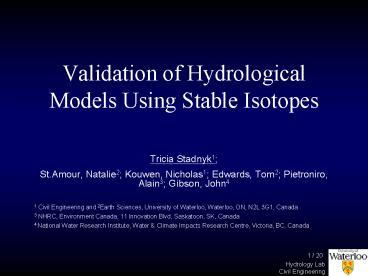Validation of Hydrological Models Using Stable Isotopes - PowerPoint PPT Presentation
1 / 20
Title:
Validation of Hydrological Models Using Stable Isotopes
Description:
Civil Engineering. 1 / 20. Validation of Hydrological Models ... 1 Civil Engineering and 2Earth Sciences, University of Waterloo, Waterloo, ON, N2L 3G1, Canada ... – PowerPoint PPT presentation
Number of Views:67
Avg rating:3.0/5.0
Title: Validation of Hydrological Models Using Stable Isotopes
1
Validation of Hydrological Models Using Stable
Isotopes
- Tricia Stadnyk1
- St.Amour, Natalie2 Kouwen, Nicholas1 Edwards,
Tom2 Pietroniro, Alain3 Gibson, John4 - 1 Civil Engineering and 2Earth Sciences,
University of Waterloo, Waterloo, ON, N2L 3G1,
Canada - 3 NHRC, Environment Canada, 11 Innovation Blvd,
Saskatoon, SK, Canada - 4 National Water Research Institute, Water
Climate Impacts Research Centre, Victoria, BC,
Canada
2
Overview
- Objectives
- Modelling Background
- Hydrological model
- Tracer module
- Study Site
- Fort Simpson, NWT
- Results
- Wetland connectivity
- Early break-through
- 1997 Simulation
- Conclusions
- Future Work
3
Objectives
- To validate the partitioning of water in a
hydrological model using d18O and d2H isotopes - Sources
- Flow paths
- Water balance
- Model isotopic fractionations within a
hydrological model framework - Quantification of flow paths
- Water cycling and budgets
4
Hydrological Model
- The WATFLOOD Hydrological Model
- Developed over the past 30 years by Dr. Nicholas
Kouwen - Primary application is flood forecasting and
flood studies - Long time sequences for climate studies
- Model very large and small areas
- 1,700,000km2 for the MacKenzie River
- 20km2 for Tri-Creek, Alberta
- Optimal use of gridded data sources
- Land cover, DEMs, Radar data
- Universally applicable parameter sets
- Quick turn around time
5
Hydrological Modelling
6
Tracer Module Components
Tracer 0 Baseflow separation
Tracer 1 Sub-basin separation
Tracer 2 Land-cover separation
Tracer 3 Rain-on-stream tracer
Tracer 4 Flow-type separation - surface -
interflow - baseflow
Tracer 5 Snow-melt as a fn(flow-type) - surface
surface melt - interflow melt drainage -
baseflow interflow melt drainage
Tracer 6 Glacial Melt - surface - interflow -
baseflow
7
E.g. Baseflow Tracer Model
- Add tracer to groundwater inflow to stream
- Mass IN Conc qlz Dt
- Calculate mass of tracer leaving stream reach
(iterative) ? ROUTING - Tracer storage balance in the reach
- S2 S1 (In Out) / 2
- Calculate tracer concentration in the reach
- Tracer STORED / Channel Storage
- Calculate tracer mass leaving the reach
- Mass OUT ConcQstreamDt ConcEvap Dt
- - corrected for evaporative losses to preserve
mass - Mass OUT Mass IN (for next reach)
8
Study Site
http//atlas.gc.ca/site/english/maps
http//www.fortsimpson.com/
- Near to community of Fort Simpson, NWT
- Confluence of MacKenzie and Liard Rivers, Canada
- Inter-relationship via spring melt
- 5 river basins studied
- Ranging from 202 - 2,050km2
- April ? August 1997 to 1999
http//www.fortsimpson.com/
9
Basin Delineation
- Jean-Marie R.
- 1,310 km2
- Martin R.
- 2,050 km2
- Birch R.
- 542 km2
- Blackstone R.
- 1,390 km2
- Scotty R.
- 202 km2
The Lone rain gauge
10
Landcover Data
- Semi-permafrost
- Wetland dominated
- 65 organic peat
- Most vegetation is transitional
- NW-W ? relief
- Martin steepest
- Scotty flattest
Red/Orangemixed/decid Greenconifer Yellowtransi
tional Light bluewetland Dark bluewater
Töyrä, Jessika, 1997
11
Results
- Accuracy of simulation determined by
- Simulated Q ?? Measured Q
- Nash-Sutcliffe coefficient (R2) and Dv
- Modelled GW ? GW-d18O and GW-d2H
- Proportionality plots
- Isotopes identified problems with wetland
connectivity to channel - Hydraulically connected v. disconnected
- Early break-through problems
- Implementation of a dispersion coefficient
12
Wetland Connectivity
- E.g. Birch river 25 total area as wetlands
(LandSAT)
?? About 10 of the wetland coverage is directly
interacting with the channel
13
Early Break-Through
- Flow Component gt Total Flow
- Result of instant mixing with large grid sizes
- Added retardation coefficient to disperse tracer
movement - Based on Pechlet number
- Constrains mass concentrations to a maximum of
1.0 in any given time step - Excess is put into stream at a later time step
14
1997 Simulation
- Reasonable fit
- R2 from 0.9 (Jean-Marie) ? 0.5 (Blackstone)
- Dv from 1 (Birch) ? 33 (Blackstone)
- Missed summer event
- Rain gauge error
15
BaseflowSeparation
- Baseflow is consistently under-estimated
- Too much dispersion (?)
- Wetland connectivity not constant
- Baseflow does not include water in wetlands
- Isotopically, it might!
16
Total Flow Separations
- S(GWIFSW) ? Simulated flow
- Water in wetlands
- Rain on stream/wetlands
17
Flow Separations
- Reasonable results
- No SW or IF isotopes for comparison
- No early break-through
- S(GWSWIF) ? Simulated Q
- (but not exactly)
- Wetland water
- Rain
- Dispersive error ?
18
Conclusions
- Reliable precipitation is critical in producing
reasonable streamflows (duh!) - At least 1 rain gauge per basin
- Wetland hydraulic connectivity
- Use isotopes to help quantify the degree of
connectivity - Identify any seasonal interactions and releases
(i.e. Deltas)
- Accounting for dispersive effects
- Simulate dispersive mixing to avoid early
break-through - Allows use of large grid sizes and simplified
routing
- Incorporation of isotopes are invaluable for
hydrologic modelling!! - Identification of model errors or inaccuracies
- Validation of modelled flow paths
- How much water? From where?
- Snowmelt quantity and timing
- Evaporative losses
19
Future Work
- New study sites for modelling
- More isotope data required
- Good meteorological data
- Model isotopic fractionation
- Focus on evaporation in WATFLOOD
- Coupling with WATCLASS (energy balance model)
- Wetland connectivity estimation
- Based on LandSAT imagery
20
Acknowledgements
- Natural Sciences and Engineering Research Council
(NSERC) for funding - University of Waterloo, Graduate Student
Association for travel assistance - Departments of Civil Engineering and Earth
Sciences, University of Waterloo - Dr. Bill Annable for his guidance suggestions































